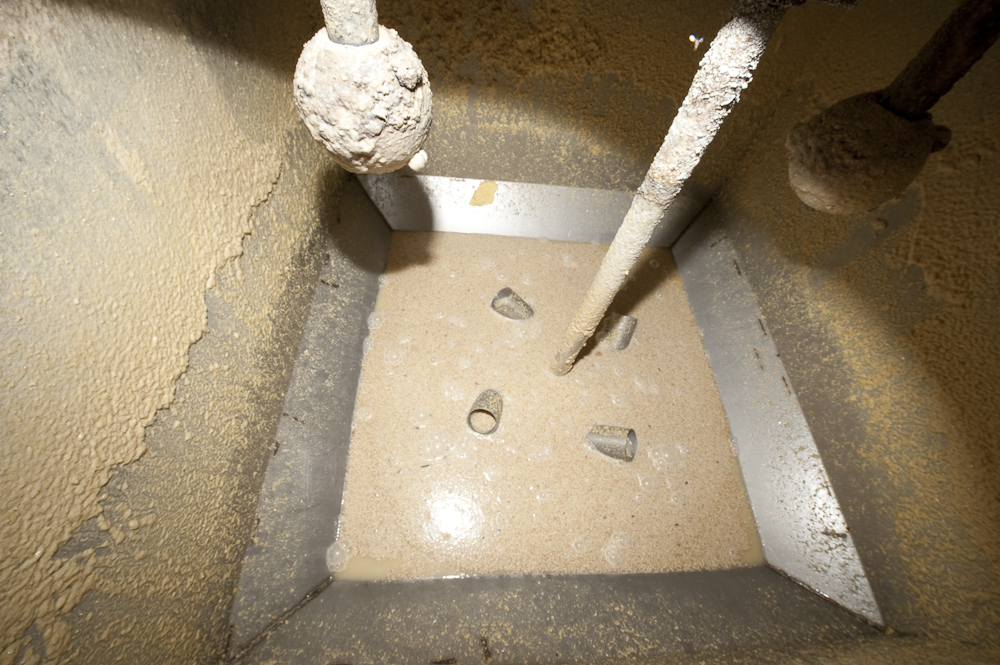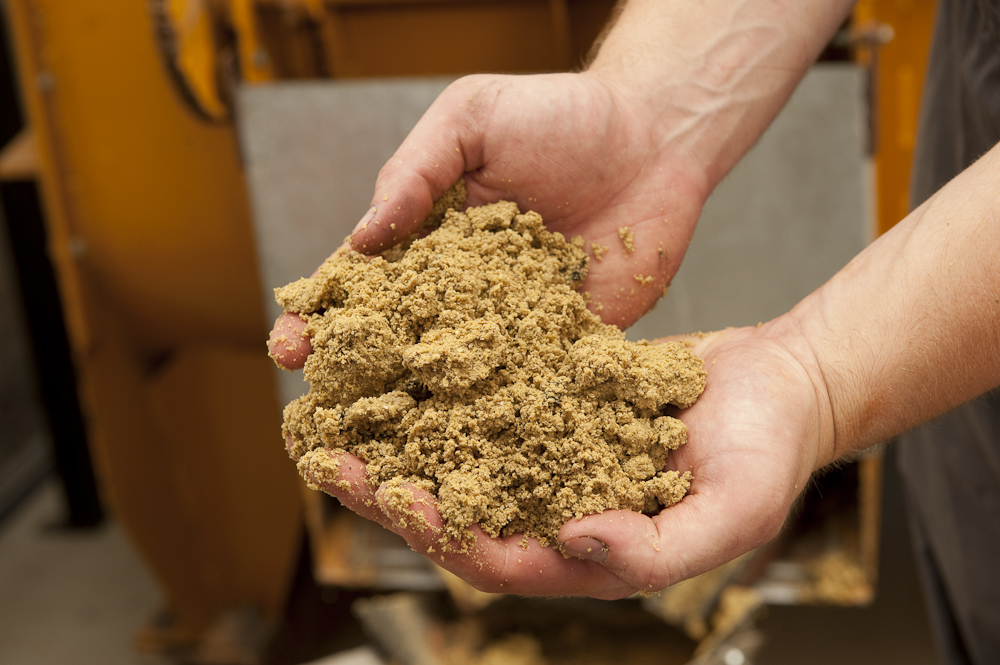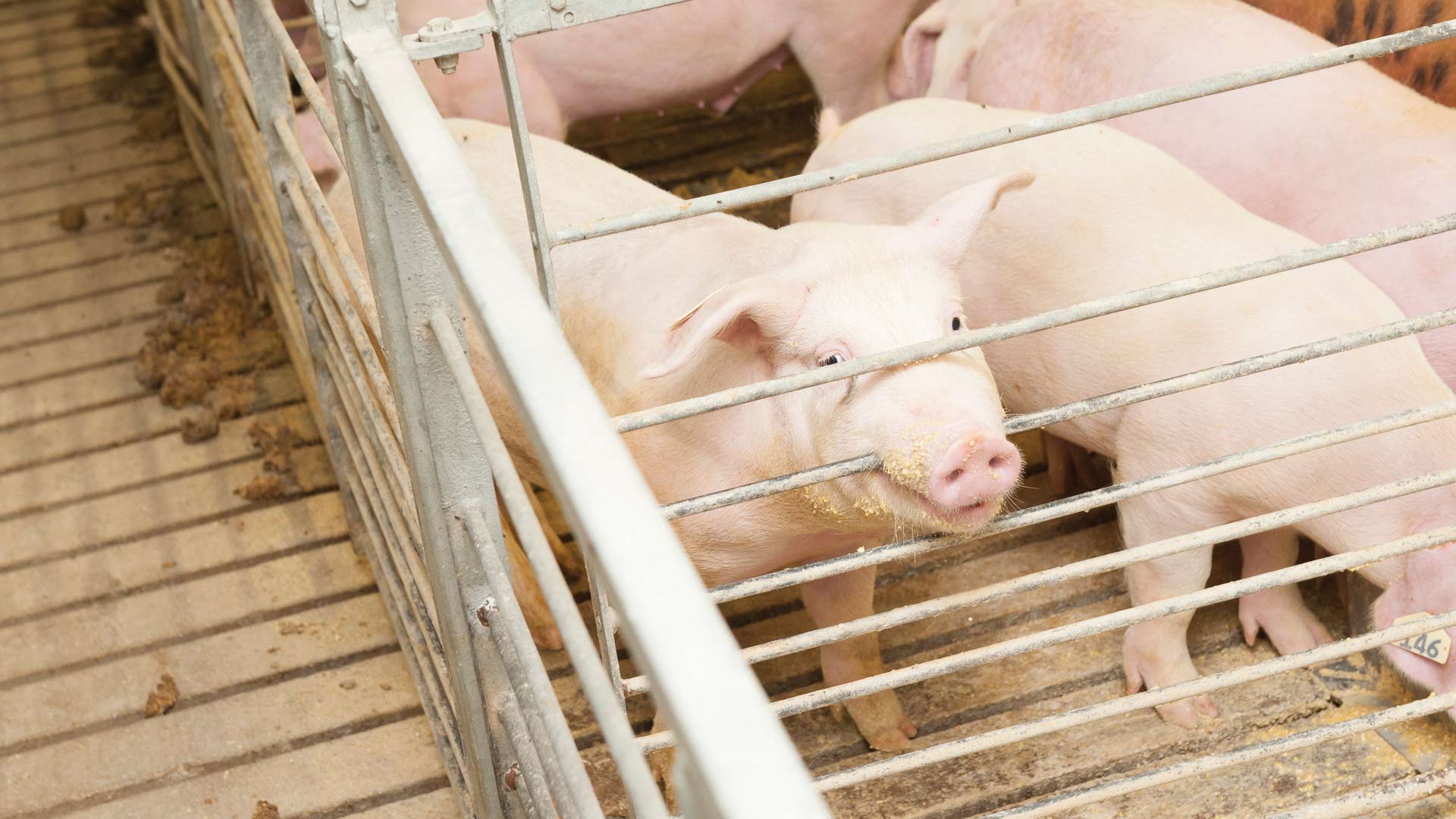–By Liz Morrison
In the old days, pigs were fed slops, a watery slurry of kitchen scraps and grain. Now, “slops” — or liquid feeds — are coming around again, as pork producers seek new ways to use low-cost ethanol coproducts.
A recently completed study, sponsored by AURI, the Minnesota Pork Board and the Minnesota Corn Research & Promotion Council, examined the effects of feeding pigs liquid rations containing wet distillers grains and solubles. The trials found that pigs fed liquid diets grew just as well as pigs fed conventional dry feed.
The research could help both hog farmers and the ethanol industry save money, says Denny Timmerman, AURI senior project development director. Hog producers could feed
less-expensive wet ingredients without sacrificing performance. The ethanol industry could gain a larger market for wet coproducts, cutting energy use and drying costs.
The project also demonstrated the use of a versatile liquid feed system — new to Minnesota — which allows producers to handle lower-value wet feedstuffs.
DDGS an important swine feed
Dried distillers grains with solubles, or DDGS, are a common ingredient in swine rations. About 12% of the nation’s 32 million metric tons of distillers grains were fed to pigs last year, according to the Renewable Fuels Association.
Cattle producers often feed wet distillers grains, which typically cost about one-third as much as the dried product, says Trevor Kallop, a merchandiser for Renewable Products Marketing Group, Shakopee, Minn. Most U.S. hog farmers aren’t set up to handle high-moisture feedstuffs, but interest is growing as pork producers cope with tight profit margins, says Alan Doering, AURI coproducts scientist.
Past research suggests that liquid feeding can increase feed intake and growth in newly-weaned baby pigs, leading to improved health, says Sam Baidoo, a livestock scientist at the University of Minnesota, who led the research trials. “Pigs are slop eaters!” And in hot weather, pigs eat liquid feed more readily than dry feed.
Liquid feed also has environmental advantages. It reduces nitrogen excretion and cuts the amount of dust in the barn, a respiratory benefit for both pigs and workers.
Liquid swine feeding does pose challenges, Baidoo says. The nutrient content of alternative feed ingredients often varies more than dry feeds. Wet feeds are more perishable, complicating logistics and storage. And the ratio of dry matter to liquid in the ration must be carefully controlled to make sure pigs get enough nutrients for optimum growth.
Six diets tested
The recent AURI feeding trials were performed at the University of Minnesota Southern Research and Outreach Center in Waseca. The study compared six diets — three dry and three liquid — on 480 wean-to-finish pigs. Treatments included:
- Conventional corn and soybean diet

- Dry diet with 30% dried distillers grains and solubles
- Dry diet with 30% spray-dried concentrated distillers solubles
- Liquid diet with 30% concentrated distillers solubles
- Liquid diet with 30% wet distillers grains
- Liquid diet with 30% wet distillers grains with solubles.
Guardian Energy, a 100-million-gallon ethanol plant in Janesville, Minn., supplied the ethanol coproducts. A modified Big Dutchman liquid feeding system was used to mix the rations with water and pump the thin slurry to individual feeding troughs.
The research found that “liquid feeding of ethanol byproducts did not negatively affect performance and carcass characteristics of wean-to-finish pigs,” Baidoo says. Key profitability measurements — including average daily gain, gain-to-feed ratios, and meat quality — were similar for all six treatments, he says.
Cost savings the main benefit
An economic analysis of the diets is not yet available. However, the liquid formulations offer “significant feed cost savings with no performance penalty,” AURI’s Doering says.
The cost savings could extend to liquid diets containing other alternative feedstuffs, too, Baidoo says. In Canada, for example, swine facilities are often located near dairy plants to take advantage of cheese or yogurt processing byproducts such as liquid whey.
Likewise, ethanol plants could cut drying costs if demand for wet coproducts rises, Timmerman says. Currently, “the market for wet cake is very quickly saturated,” Kallop says. At Guardian Energy, for example, “We dry everything here because there hasn’t been a market for wet distillers grains,” says Dean Reder, chief financial officer. “If a market opened up, we’d be interested in looking at that.”
Results of liquid feed trials
The first of several AURI-sponsored liquid swine feed trials at the Southern Research and Outreach Center in Waseca found that:
- Pigs that ate liquid feed gained just as much weight each day as pigs that ate conventional dry feed.
- Carcass weight and meat quality were similar for all the diets.
- Gain-to-feed ratios were similar for all the diets. (The gain-to-feed ratio is the amount of food an animal must eat to gain one pound.) However, subsequent trials at Waseca have shown a significant gain-to-feed advantage for liquid diets, says University of Minnesota livestock scientist Sam Baidoo, research leader. That lowers the cost of producing a pound of pork.
- Nursery pigs fed wet distillers grains and solubles gained more weight per pound of feed during the critical first two weeks after weaning than nursery pigs fed a dry diet.
- Pigs on the liquid diets consumed about half a gallon more water per day than pigs fed a dry diet.
- Pigs fed a liquid diet had healthier intestinal tracts.
- There was less spillage and wasted feed in the liquid feed groups.
AURI and swine liquid feed trials
Idea to reality:
U.S. hog producers use large amounts of dried distillers grains with solubles (DDGS) in swine rations. There’s interest in using liquid swine feeding systems, which would enable farmers to feed less-expensive wet or liquid ethanol coproducts. Farmers needed to know if feeding liquid ethanol coproducts would affect pigs’ growth or meat quality.
AURI’s role:
AURI sponsored feeding trials at the University of Minnesota Southern Research and Outreach Center in Waseca, Minn., which compared the performance of pigs fed liquid and those fed dry diets containing ethanol coproducts.
Outcomes:
Feeding ethanol coproducts in liquid diets did not reduce swine growth or meat quality. The research will help hog producers make informed decisions on the use of liquid ethanol coproducts. It will also help the ethanol industry expand markets for wet products, thereby cutting energy use and feed drying costs.
Partners:
University of Minnesota Southern Research and Outreach Center, Minnesota Corn Research & Promotion Council, Minnesota Pork Board, and Guardian Energy, Janesville, Minn.
Ethanol coproducts
 Wet distillers grains: Also called “wet cake.” The portion of the corn kernel that’s left after the starch is removed and fermented for ethanol. Wet distillers grains contain protein, fiber, fat, and about 35% moisture. The product has a shelf life of four or five days. It is fed primarily to cattle.
Wet distillers grains: Also called “wet cake.” The portion of the corn kernel that’s left after the starch is removed and fermented for ethanol. Wet distillers grains contain protein, fiber, fat, and about 35% moisture. The product has a shelf life of four or five days. It is fed primarily to cattle.
Concentrated distillers solubles: The concentrated residue remaining after fermentation. Distillers solubles are about 70% moisture and contains nutritious solids. They may be sprayed on wet distillers grains to produce distillers grains with solubles (DGS) and can also be dried to produce dried distillers solubles (DDS). The market for distillers solubles is limited.
Dried distillers grains with solubles: Wet distillers grains that have been dried along with the concentrated distillers solubles to about 12% moisture. Dried distillers grains with solubles (DDGS) have a long shelf life and can be packaged and traded as a commodity.

